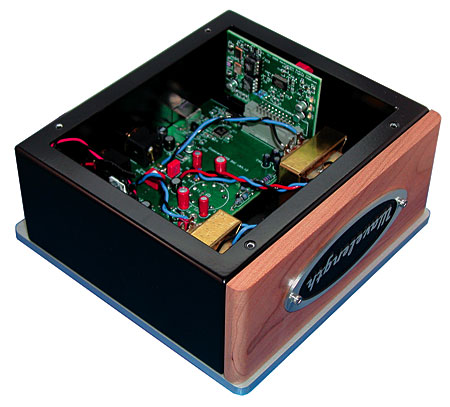| Columns Retired Columns & Blogs |
Wavelength Cosecant v3 USB digital/analog converter Page 2
For its part, the Cosecant's outboard power supply was well beyond the usual wall wart in design and execution, with a neat, robust circuit board, high-quality parts—especially the transformer, regulators, and heatsinks—and an attractive exterior of extruded aluminum. When this power supply collected dust bunnies, I felt guilty and cleaned them away.
Footnote 3: Whereas the original AIFF format stored the audio data in "big-endian" fashion, ie, each word starts with the MSB and ends with the LSB, the "sowt" variant stores each word the other way round, ie, LSB to MSB or "little-endian," signified by the fact that "sowt" is "twos" written in little-endian fashion.—John Atkinson
Installation and setup
Despite—or perhaps owing to—its apparent sophistication of design, installing the Wavelength Cosecant took no more than 10 minutes, from shipping carton to system. Within another minute, it was making music and sounding good.
I'd prepared for the review by ripping about 60 complete albums and a few dozen individual songs to the internal hard drive of my 2008 Apple iMac, which runs the Mac OS X v10.5.4 operating system. I also downloaded the files needed to upgrade my copy of Apple iTunes' music-playback software to the latest version (8.0.2). Why iTunes? Because it's free—and because its user interface is satisfactory, if not quite perfect. Unfortunately, iTunes doesn't yet support the popular FLAC lossless file format, so I wasn't able to try all of the codecs, uncompressed and otherwise, that the Cosecant is intended to complement.

Ultimately, I decided to rip my music using the uncompressed if space-hungry AIFF format (actually AIFF-C/sowt, the functionally identical AIFF variation introduced with Mac OS X 10.4.9, footnote 3). Although I can't say what audible differences, if any, might exist between the various uncompressed file formats, I did spend the better part of one afternoon comparing selections ripped in AIFF, ALC, and MP3. Although the differences were subtler than I'd expected, AIFF was best in every way: musical flow, drama, overall freedom from listening fatigue, and lacks of pitch-relationship distortion, unnatural grain, and edginess. I was also surprised that, to my ears, there wasn't nearly as great a distinction between MP3 and ALC as there was between ALC and AIFF. In any event, and above all, AIFF had the best, most natural flow and momentum, while ALC tended to be comparatively uninvolving.
Back to the Cosecant. Installation was simply a matter of: connecting and plugging in the Wavelength's remote power supply, connecting its USB input socket to one of the USB sockets on the back of my iMac (or the edge of its keyboard), and connecting its line-level output jacks to the inputs of my Shindo Masseto preamplifier. Then I brought up my iMac's System Preferences window and clicked on the Sound icon: the choice of "Cosecant USBDAC" was right there waiting for me. It took less time to install the Cosecant than to cue up an LP on some of the more ridiculously fiddly high-end turntables I've seen.
Performance
During my weeks with the Wavelength Cosecant v3, only one glitch intruded: My review sample produced a bit of hum, slightly audible when the volume control was set for normal playback levels. I tried floating the AC ground and reversing polarity with a cheater plug, and I tried altering the distance between the Cosecant and both its power-supply box and the other components in my system, but none of those made a difference. Finally, I tried connecting a simple ground wire from its chassis to that of my Shindo preamp. Voilà: The background silence was complete. The ground wire stayed in place.
As I hinted earlier, the Cosecant hit the ground running; for that reason, and for the sheer novelty of having such a thing in my system, I left it on for the next eight hours, for serious listening and background music alike.
But during its ninth hour in my system, the Cosecant's performance kicked into a higher gear: It would no longer do as background music. As I listened to guitarist David Grier's recent Live at the Linda (CD, Dreadnaught 0701), the playing began to seem even more nuanced, more human than before, and the sound of his beautiful 1946 Martin D-28 became more substantial and present. Literally, the bass strings were deeper and more colorful, and the treble strings more brilliant, yet at the same time more timbrally substantial. All at once, everything clicked into place and stayed there.
In the weeks that followed, it seemed that roughly nine out of ten digital music selections sounded better as AIFF files played through the Wavelength Cosecant v3 than as CDs through my Sony SCD-777ES SACD/CD player (footnote 4), or the very-different-sounding Sony PlayStation 1. While certain distinctions varied from disc to disc, certain performance characteristics remained consistent: Music played through the iMac-Cosecant combination was marginally more involving and sounded notably clearer and more open, something I came to attribute to a reduction in very subtle, low-level, between-the-notes noise. A very few discs—mostly recent releases of simple, well-recorded acoustic music, such as the aforementioned David Grier album—also sounded punchier and more dramatic through the Cosecant v3. All in all, going from a CD player to a computer-based digital music system wasn't as drastic as the move from digital to analog, but it had many of the same qualities.
Footnote 3: Whereas the original AIFF format stored the audio data in "big-endian" fashion, ie, each word starts with the MSB and ends with the LSB, the "sowt" variant stores each word the other way round, ie, LSB to MSB or "little-endian," signified by the fact that "sowt" is "twos" written in little-endian fashion.—John Atkinson
Footnote 4: Comparisons were made with the Sony set to its Filter 1—more or less the standard of its many switchable PCM slopes.—Art Dudley
- Log in or register to post comments




































